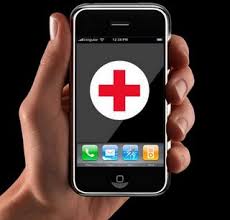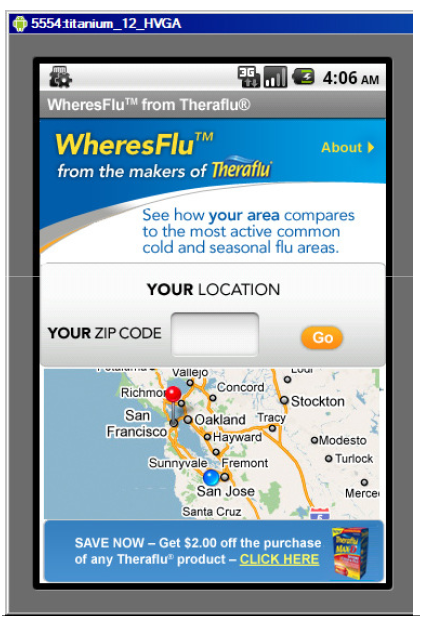February 27th, 2011 by Bryan Vartabedian, M.D. in Better Health Network, Opinion
No Comments »

 This is something. Jay Parkinson on the Future Well blog has suggested that health apps are overrated. Then on Twitter came a remark that the post represented “fightin’ words.” While I think the tweet was in jest, I’m sure there are some who will take offense to the less-than-flattering remarks about our coveted health apps.
This is something. Jay Parkinson on the Future Well blog has suggested that health apps are overrated. Then on Twitter came a remark that the post represented “fightin’ words.” While I think the tweet was in jest, I’m sure there are some who will take offense to the less-than-flattering remarks about our coveted health apps.
We love the concept of health apps for what they represent more than for what they really offer us. We want to feel that we’ve got it all in the palm of our hand. After all, technology might do for us what we won’t do for ourselves.
Like Jay I’m underwhelmed, but I don’t think that’ll always be the case. The post’s criticism should start a conversation about what’s real in mobile health and what isn’t. Even the fantasy of Health 2.0 has been questioned, and that’s a good thing. This dialog about reality versus rainbows and unicorns needs to continue.
Youngme Moon in Different: Escaping the Competitive Herd wrote, “The way to keep criticism from devolving into cynicism is to make it a starting point rather than a punctuation mark.” Jay Parkinson’s post is a starting point.
*This blog post was originally published at 33 Charts*
February 18th, 2011 by Berci in Better Health Network, Health Tips
No Comments »

As a part of the TheraFlu campaign, Novartis has developed free Android, Blackberry and iPhone applications for tracking flu outbreaks in the U.S. These days it’s become inevitable to develop free apps on all platforms in order to promote your product. From Novartis:
 Keep up-to-date on the most active cold and flu reports around the country. The WheresFlu™ app follows sickness incidence levels from week to week and keeps track of the current top 5 affected cities in the nation. The WheresFlu™ app will find your current location and provide you with results for that area. Or you can enter a ZIP code to get information for that area.
Keep up-to-date on the most active cold and flu reports around the country. The WheresFlu™ app follows sickness incidence levels from week to week and keeps track of the current top 5 affected cities in the nation. The WheresFlu™ app will find your current location and provide you with results for that area. Or you can enter a ZIP code to get information for that area.
If you’re wondering how it actually works and how it differs from Google Flu Trends, here it is:
WheresFlu™ measures weekly activity for cold and flu based upon real-time reports of symptoms from SDI FAN® (a source used by the Centers for Disease Control and Prevention). As the longest-running respiratory tracking program in the US, SDI FAN® covers illness levels in 135 regions across the country utilizing panel-member reporting along with patient-specific data. Advanced tracking uses illness status levels to predict change in the affected population for the nine US Census Regions.
*This blog post was originally published at ScienceRoll*
January 1st, 2011 by Berci in Better Health Network, Research
No Comments »

 From Blog 4 Global Health — an “interactive blog from the Global Health Council’s Policy, Research and Advocacy team” — here’s The Top 10 in 2010 Global Health Communication. An excerpt:
From Blog 4 Global Health — an “interactive blog from the Global Health Council’s Policy, Research and Advocacy team” — here’s The Top 10 in 2010 Global Health Communication. An excerpt:
If global health communication was characterized by anything in 2010, it was the rise of Twitter and other social media among non-profit organizations as a way of bypassing increasingly irrelevant traditional media and taking their messages directly to their target groups. From the Global Health Council, we saw more and more of our members — large and small — embracing new media like blogging, micro-blogging and social networks like Facebook. At the year’s last meeting of our Global Health Communicators Working Group in November, I asked for a show of hands of those whose organizations were not using social media. No hands went up.
*This blog post was originally published at ScienceRoll*
December 23rd, 2010 by Felasfa Wodajo, M.D. in Better Health Network, News, Opinion, Research
No Comments »

 At this past October’s Health 2.0 meeting in San Francisco, many great new ideas about the future of healthcare were presented with a special emphasis on technology. For a great overview check out the keynotes by Jeff Goldsmith & Tim O’Reilly. The conference, organized by Matthew Holt & Indu Subaiya started in 2007 and bills itself as the “the leading showcase of cutting-edge technologies in healthcare.” Those not lucky enough to attend the conferences can follow along on the Health 2.0 blog.
At this past October’s Health 2.0 meeting in San Francisco, many great new ideas about the future of healthcare were presented with a special emphasis on technology. For a great overview check out the keynotes by Jeff Goldsmith & Tim O’Reilly. The conference, organized by Matthew Holt & Indu Subaiya started in 2007 and bills itself as the “the leading showcase of cutting-edge technologies in healthcare.” Those not lucky enough to attend the conferences can follow along on the Health 2.0 blog.
Besides exploring the overarching themes of the future of healthcare in general and health IT in particular, many innovative companies, young and old, gave on-stage demos at the conference. One demonstration in particular stood out for me. This was the demo by the Accelerator Apps Network which showed the future of interconnected companies and applications seamlessly exchanging patient information. The Health 2.0 Accelerator Apps Network is a non-profit industry consortium launched by the Health 2.0 company. Read more »
*This blog post was originally published at iMedicalApps*
December 23rd, 2010 by Berci in Better Health Network, Health Tips, News
No Comments »

HealthMash, WebLib’s next-generation semantic health search engine, will release an iPhone application in January. It utilizes proprietary natural language processing and semantic technology tools and resources in order to find highly relevant, reliable, and recent health information from the most trusted sources and facilitate user exploration and discovery.

*This blog post was originally published at ScienceRoll*
This is something. Jay Parkinson on the Future Well blog has suggested that health apps are overrated. Then on Twitter came a remark that the post represented “fightin’ words.” While I think the tweet was in jest, I’m sure there are some who will take offense to the less-than-flattering remarks about our coveted health apps.




 Keep up-to-date on the most active cold and flu reports around the country. The WheresFlu™ app follows sickness incidence levels from week to week and keeps track of the current top 5 affected cities in the nation. The WheresFlu™ app will find your current location and provide you with results for that area. Or you can enter a ZIP code to get information for that area.
Keep up-to-date on the most active cold and flu reports around the country. The WheresFlu™ app follows sickness incidence levels from week to week and keeps track of the current top 5 affected cities in the nation. The WheresFlu™ app will find your current location and provide you with results for that area. Or you can enter a ZIP code to get information for that area.

 At this past October’s
At this past October’s 








